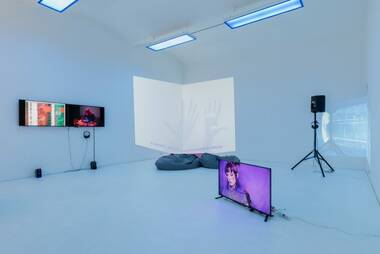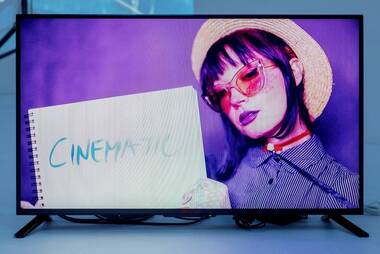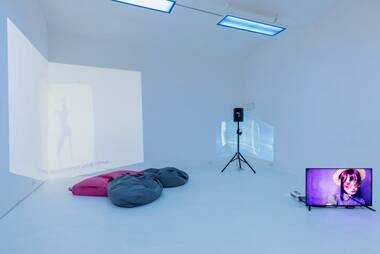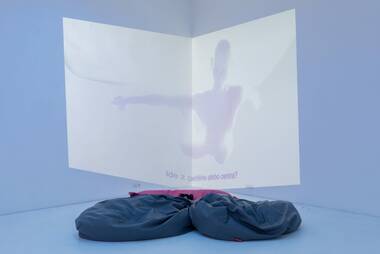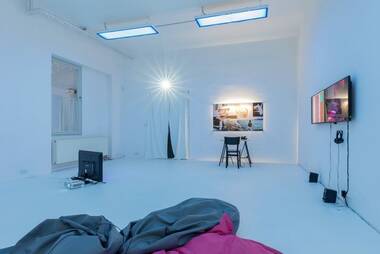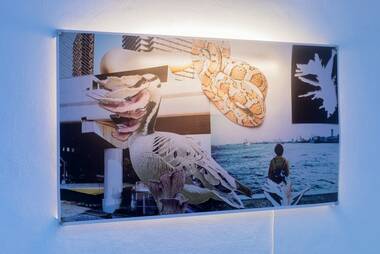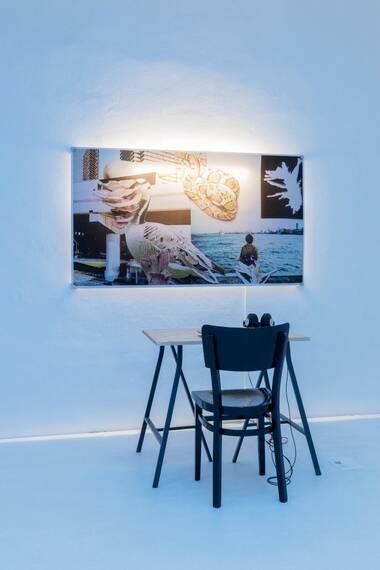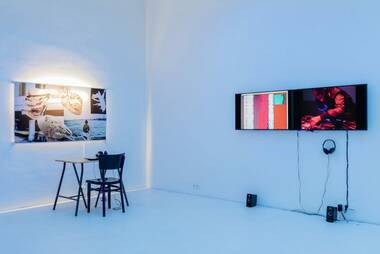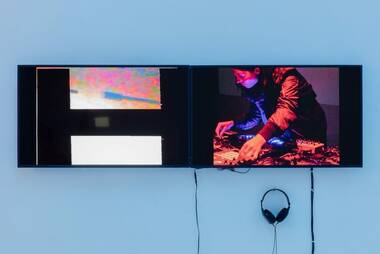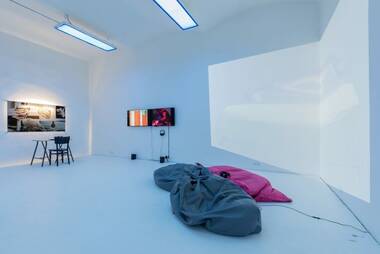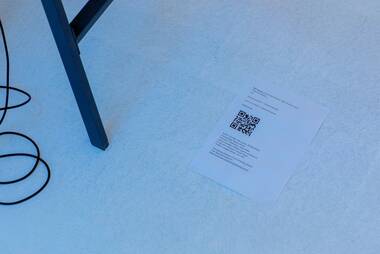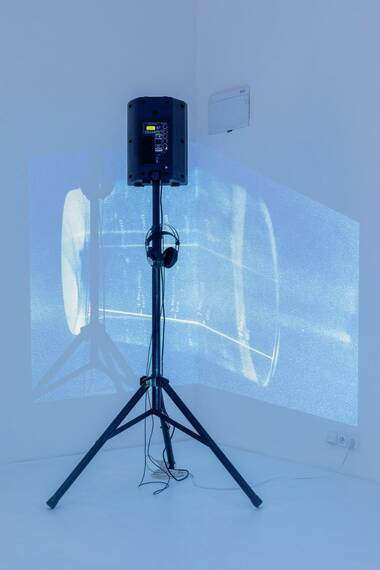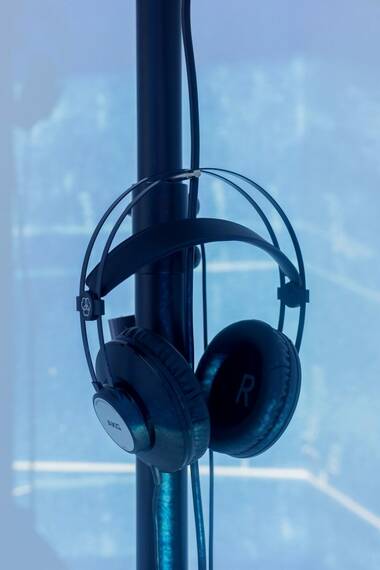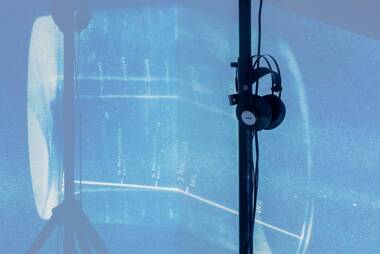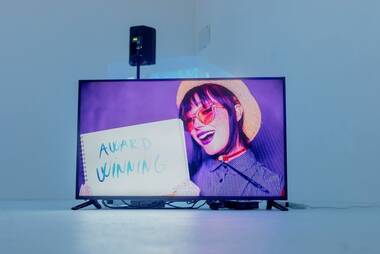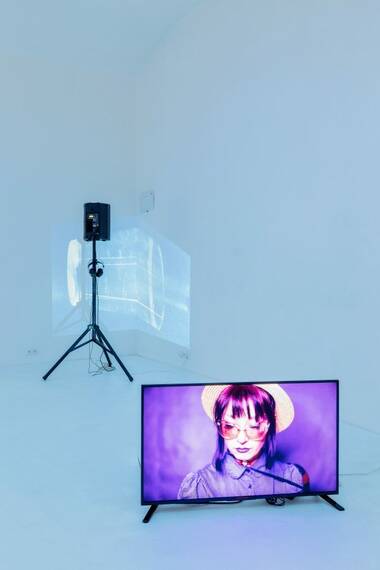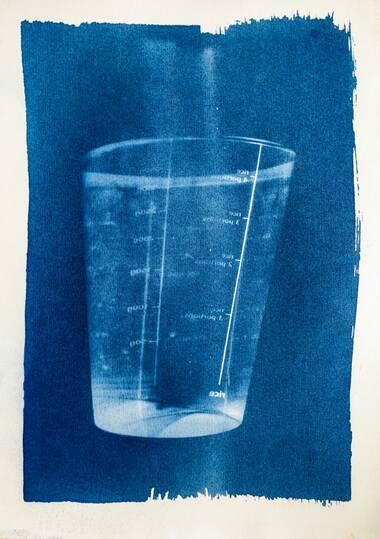On Second Thought
Brit Jensen, Lucia Udvardyova,
Tatiana Heuman, Barbora Trnková
16. 12. 2022 – 22. 1. 2023
opening: 15. 12. 2022 from 6 to 8 pm
curator: Jennifer Helia DeFelice
in collaboration with Vasulka Kitchen Brno
Jennifer, I would like to ask you when Vasulka Kitchen Brno was founded and how the idea came about?
As early as 1992 the Faculty of Fine Arts founded at the Technical University of Brno had a studio of Video-Multimedia-Performance (VMP), which was of an intermedia character with a strong emphasis on video and new media. The head of the studio, Prof. Tomáš Ruller, sought to ensure that the programme, despite limitations in budgets and equipment, included contact with current events in the Art and Technology scene. For example, he initiated a series of exhibitions called Hi-Tech Art.
The need to build an archive arose directly from the curriculum. Despite the fact that no funds earmarked for it, we collected what we could, mostly through personal contacts with the international scene during visits to exhibitions, symposia, or at institutions such as Ars Electronica, V2 Lab for Unstable Media, or the Osnabrück European Media Art Festival. Both Woody and Steina Vašulka were important personalities and frequent visitors to the studio. They donated a copy of the archive of their own works to the studio and organized lectures and screenings at the studio. Other international personalities who were important for the establishment of the VMP Media Archive included Chris Hill and Keiko Sei and many others who accepted the invitation to come to Brno in the 1990s. With the building of Vasulka Kitchen Brno, the original intention, which had already been established in the early 1990s, was finally fulfilled: a space for preserving important documents and historical milestones with links to work with new media, both on the local scene and abroad.
We were able to establish Vašulka Kitchen Brno (VKB) as an association in 2016 after having acquired several of Vašulka's prints from the Lucifer's Commision and Triads series, and a long term loan of Woody and Steina Vašulka's audiovisual installation Light Revisited, alongside the digital archive of the Vašulka's work and media library of associated documents. The acquisition of a dedicated space at the Brno House of Arts through the support of the city of Brno then made it possible to present these works of art and the extensive archive to the public and to create a platform for further research, study, and an accompanying programme. From its inception the intention was for the center to function as an open platform connecting artists, theorists, and initiatives in the field of art and technology in the Czech and international context.
Could you mention what the current activities of this organization are and how the program is being developed? Do you often focus on collaboration with international artists?
The VKB program consists of the diverse activities of all its members. We work in numerous ways simultaneously. All of its members and their activities form an ornament that has all kinds of shapes and surfaces made of different forms with the potential to evolve further touching on the diverse corners of the fields of new media, art, and technology - or art and science. I consider it most important to preserve a working model that provides the opportunity to mirror the broad spectrum of work in the field of new media art artistically, academically, theoretically, or from an archival perspective. We consider it important to establish collaborations with people who have long been engaged with themes of digital media, art and technology, and theory that reflect the current state of our coexistence with technology, and who are also able to creatively project their vision, personal interpretation, and reflection in their work.
Over the past three years we have held numerous events which makes it difficult to choose. All of our encounters with international artists are important for us since the aim is to create a network of communication and collaboration. For example, our cooperation with Petr Svárovský, a Czech artist who has been living and working in Norway for a long time, prepared a mobile application Fleky for VKB which creates a specific guide to Brno with a unique interpretation by the KKRD Boys; Joseph Nechvatal, an American artist living in France, made the presentation Immersion Into Noise for VKB; Haraldur Karlsson, an Icelandic artist, completed a residency with VKB in cooperation with the House of Arts Artist in Residency program in 2021, and we prepared his exhibition Time Aside together this year. These are a few recent examples. But the artists who live here are equally important to us, such as Jiří Suchánek, Barbora Trnková or Helena Lukášová, with whom we have collaborated on artistic performances, workshops, and other programs.
The exhibition On Second Thought was created in collaboration with Vašulka Kitchen Brno. Could you tell us what was the key to selecting the artists? Can you also mention the individual works?
Originally, I was hoping to exhibit works by Barbora Trnková, who has been actively working in the field of net art and digital media since her studies at FaVU in the Body Design studio. For some time I had been considering how to create an opportunity to present Barbora's work, as she seemed to be very involved in curatorial and theoretical projects, and based on our countless conversations I was curious what an exhibition of her work would convey. Although there was a preliminary concept, it became increasingly clear that we would have to consider an exhibition consisting of several works due to the artist's time capacity. In previous years I had come across several artistic practices that, while not specifically in the realm of fine art in the typical sense, were closer in form to experimental research. This way of working seemed to be in line with Barbora's approach, which gradually became a concept of removing the works from their original contexts and presenting them to an audience in the gallery context. For example, an episode from a podcast or a website, from Vimeo or YouTube, and creating listening or viewing situations. The work Cyanotypes, which is an ASMR reinterpretation of a cyanotype, is another example of extrapolating a work into a physical space, however intangible.
The blue light in the gallery is interesting. When we were preparing the exhibition, we talked about the fact that at a certain moment during the day there is an effect called the "blue moment." Is that what you wanted to achieve by using this hue of luminosity?
Essentially, the term "blue moment" refers to a period of twilight. With the approach of dawn or dusk the exposure value of everything that the light touches comes closer together. There are no bright highlights, nor deep, dark shadows and this creates a sense of suspension.
In the gallery I was hoping to achieve the sense of a photographic studio. The blue color is also based on the cyanotype which is a central theme of the overall concept. Correcting the lighting conditions is also a reference to a 3D virtual world where we can choose the background or a reference to the earlier green or blue screen technology which is used in the video or film industry. We see a similar space in How to Hypnopomp? by Tatiana Heuman, where a vague space creates a mood for the viewer's experience, a kind of undefinable space.
I have long admired the work of audio documentarian Brit Jensen. I was intrigued by the idea of exhibiting the Anatomy of Fear podcast. The authors of the podcast wanted to record and retell the real fear of real people, moment by moment. They also wanted to try to get to the heart of that fear, which is why they chose first-person narration — the narrators always tell their own stories — instead of a third-person horror perspective. In the process, they stumbled upon some fundamental aspects of how we usually imagine and share our fears. When a fear story is told from the inside, it is more subtle and slower, more relatable to the storyteller, and less fear-inducing to the viewer or listener. These stories about fear leave room for things other than the fear itself, for thoughts, reflections, shadows — and sometimes for community. At least, that's how the stories in Anatomy of Fear are perceived by its authors.
With Lucie Udvardyova, I again admired her role as a journalist with a deep interest in electroacoustic music. As for her performance she describes it as a meditative experience, an improvisation, an immersion in sound and a layering of different soundscapes into an intricate flow. Rather than being proposed as an intellectual work, the artist concerns herself with inducing a sense of relaxation since during the day she has to be in an analytical mode, so that she can "unplug" from computers and thinking. That's also why she uses analogue instruments (she likes to work with DIY synthesizers, which are custom-made by her friends).
In the exhibition you work a lot with sound, and specifically the work of the artist Barbora Trnková employs ASMR. Could you elaborate on the sense in which the artist uses this specific sound experience?
For Barbora the piece is an an exploration of the materiality of photography, an attempt to create a self-portrait of a non-human material through the process of letting the photograph act on one's own body, in this case specifically through the technique of cyanotype, because in this process it is possible to mix chemicals and experience individual material steps on a longer timeline. And this includes exposure. To show this exposure in detail and in real time, she decided to use the ASMR (Autonomous Sensory Meridian Response) recording technique. On the one hand, it is possible to hear these processes, but also the experience she reproduces. The artist lets what takes place during the creation of the cyanotype make its "imprint" on the listener through the most immediate sound. For Barbora, it is essential to explore the fundamental moment of the action of one material on another. In the creation of a cyanotype, one can see how each material affects the individual. How water acts on salt, how a photosensitive liquid acts on paper, and how light acts on a painted surface. And finally how this process affects the artist (a material full of chemical metabolism), and then in the most direct way (via ASMR) the viewer.
The program of the Jeleni Gallery is possible through kind support of Ministry of Culture of the Czech Republic, Prague City Council, State Fund of Culture of the Czech Republic, City District Prague 7, GESTOR – The Union for the Protection of Authorship
Partners: Kostka stav
Media partners: ArtMap, jlbjlt.net, Náš REGION
and Mladý svět and UMA: You Make Art
